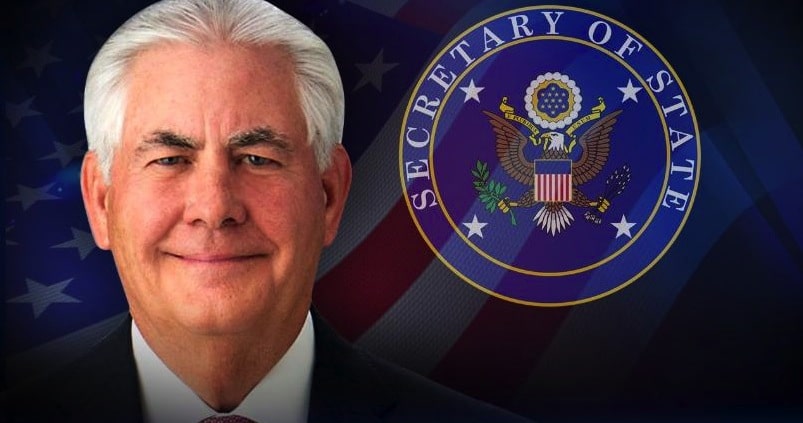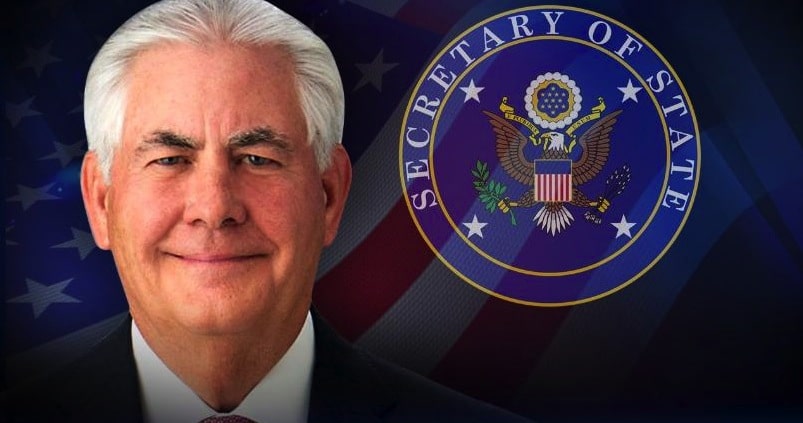What if it’s not incompetence? What if it is by design? What if President Donald Trump has decided American doesn’t really need a Department of State and if he can’t get away with closing it down, he can disable and defund it?
The only problem is Trump will quickly find out he’ll have to reluctantly keep a few lights on at Foggy Bottom.
Things do not look good for State. There were no press briefings between Trump taking office on January 20 and some irregular gatherings beginning in early March. Secretary of State Rex Tillerson wasn’t seen at several White House meetings where foreign leaders were present, and has taken only two very short trips abroad. Of the 13 sets of official remarks he has given, 10 have been perfunctory messages to countries on their national days, with one speech to his own employees. Sources inside State say he is nowhere to be seen around the building, either in person or bureaucratically via tasking orders and demands for briefings.
Meanwhile, President Trump has proposed a devastating 37 percent cut to State’s tiny budget, already only about one percent of Federal spending.
And as if that isn’t bad enough, the Trump administration has left a large number of the 64 special representative and other “speciality” positions empty. Tillerson already laid off a number of his own staff. Add in a Federal-wide hiring ban, and the only good news at Foggy Bottom is that it’s no longer hard to find a seat in the cafeteria.
The original concerns around State that Trump’s transition was in chaos seem sadly mistaken; there are too many empty slots for this to be anything but purposeful. As for Tillerson himself “Either he’s weak or he’s complicit,” one State Department official said. Neither option bodes well.
Alongside Trump himself, State is its own worst enemy. Team Trump no doubt took careful note of the Department’s slow-walking the release of Hillary Clinton’s emails (after helping hide the existence of her private server for years), and the organization’s flexibility in allowing aide Huma Abedin to simultaneously occupy jobsinside and outside of the Department, alongside alleged quid pro quo deals related to the Clinton Foundation.Senior State officials purged in late January were closely associated with Hillary Clinton. Happens when you back the wrong horse.
The already open wound of Benghazi festered just a bit more when a post-election Freedom of Information Act release revealed State covered up the fact the assault on the Consulate was not “under cover of protest” as the Obama administration claimed but was, in fact, “a direct breaching attack.” Never mind the leaked dissent memoaimed at Trump’s so-called Muslim ban, and the leaked memo admonishing State staffers to stop leaking.
And what has been one of State’s public actions this February? Dropping $71,000 on silverware to entertain foreign dignitaries. An organization that will be missed by the bulk of Trump supporters this is not.
So is this it? The end of the United States Department of State, founded alongside the republic in 1789, with Thomas Jefferson himself as its first leader?
Maybe not. Trump will quickly find that there are several State Departments, and he’ll need to hang on to a couple of them, even if he sidelines the others.
Most of the actions described above refer to the political State Department, the traditional organ of diplomacy that once negotiated treaties and ended wars, but more and more since 9/11 (maybe earlier) has been supplemented if not left behind by modern communications that allow presidents and other Washington policymakers to deal directly with counterparts abroad. Throw in the growing role of the military, and you end up with far too many State staffers having a lot of time on their hands even before Trump came along. The Wikileaks cables, years of State Department reporting from the field, contained as much filler and gossip as they did cogent policy advice.
Trump can make his deep cuts in that part of State’s work and few will even notice. In some ways, no one yet has; as far back as 2012, more than one fourth of all State Department Foreign Service positions were either unfilled or filled with below-grade employees. The whole of the Foreign Service diplomatic corps is smaller than the complement aboard one aircraft carrier, and has been for some time.
There’ll be a few functions that may need to be rolled into other parts of the government if most of State fades away: whatever refugee processing Trump allows to DHS, trade promotion to Commerce, foreign aid to perhaps DOD, all have ready homes waiting if necessary. Trump’ll need to have ambassadors abroad, not the least of which is because 30-50 percent of those positions are routinely handed out to rich campaign donors, banana-republic style.
So what is left at State Trump will need to hold on to?
Those 294 embassies and consulates abroad State operates serve a function as America’s concierge that cannot be easily replaced, and will have to be funded at some level whether Trump likes it or not.
Dozens of other US government agencies rely on State’s overseas real estate for office space and administrative support to keep their own costs down. American government VIPs traveling need someone to arrange their security, get their motorcades organized, and their hotels and receptions booked. Meetings with local officials still require on-the-ground American staff to set up. Supporting CODELS (Congressional Delegations’ visits to foreign lands) is a right of passage for State Department employees, and every Foreign Service Officer has his/her war stories to tell. While stationed in the UK, I escorted so many Important Somebody’s on shopping trips that I was snarkily labeled “Ambassador to Harrod’s Department Store” by my colleagues. Others will tell tales of pre-dawn baggage handling and VIP indiscretions that needed smoothing over.
Never mind the logistics for a full-on presidential visit to a foreign country. No, Trump will need this side of State to stay on the payroll.
The last part of the State Department Trump will need around one way or another is the Bureau of Consular Affairs. Consular performs the traditional government functions of assisting Americans overseas when they’re arrested, caught up in a natural disaster, or just need help with social security or a new passport.
The big swinging bat, however, is visa issuance. Visas are what fills the American economy with tourists, Silicon Valley with engineers, and universities with foreign students. Visas are the State Department’s cash cow: in 2016 close to 11 million tourist, worker, and student visas were issued at an average fee collected of $160. That’s well over $1.7 billion in revenue in addition to the budget Congress allots State. The Bureau of Consular Affairs holds a budget surplus in reserve whose dollar amount is one of the most closely held non-national security secrets inside government.
But in a Trumpian state of mind, what looks like a strength at Foggy Bottom might turn out to be a weakness. State fought viciously after 9/11 to hold on to consular work, even as the Bush administration sought to consolidate the consular function into the then-new Department of Homeland Security.
State won the bureaucratic fight in 2001, but if the Trump administration really wanted to effectively wipe away most of the State Department proper, it might need to do little more than kick out the strongest (and most profitable) leg holding up the whole edifice. Like a jenga tower, Trump can pick away at the top positions for media and political points, but if he really wants to see it all fall down, he’ll attack the bottom. Watch for it; it’ll tell you how serious this fight really is.
Reprinted with permission from WeMeantWell.com.


